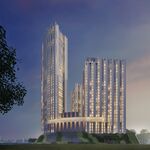There’s a few issues here as a region in whole:
1) Actual East to West travel on Hwy 7 from Vaughan to Markham doesn’t have the demand. Most of the demand is either within Vaughan along Hwy 7 or in Markham along Hwy 7. Demand falls off between Keele-Yonge-Bayview. Part of this is geographical but also the nature of zoning between here.
Sure.
But.
a) No line, no subway, bus or LRT at least of any length maintains constant demand along its entire route.
That's a very high bar to justify service delivery.
b) Highway 2/Kingston Road is similarly long in Durham Region; while there is some end to end demand headed to UTSC or the like; a great deal of the demand is more local and varies across the route.
c) There is a need to get people from the subway or a 24-hour bus replacement to somewhere. The catchment of a 10 minute walk or less to Yonge and Jane respectively doesn't cut it.
There really isn't a better candidate East-West route for a first service. It serves the emerging Vaughan City Centre, a major node at Yonge, the would-be Downtown Markham, and Markville Mall, while crossing one current and one future branch of Line 1.
2) YRT has a huge coverage area that spans between urban and very rural. The fact that York Region Council controls YRT not individual municipalities means that southern York Region is constantly jostling with the northern counterpart for service. Think of it as the inner 416 vs the suburban 416.
Durham Region has even more rural area than York Region, and likewise goes as far north as Lake Simcoe.
4) Demand and wealth are also another issue. The lower income parts of York Region are not concentrated in southern York Region but vastly spread out into the far fringes. Southern York Region also tends to be very wealthy and residents can afford multiple cars thus never having to use YRT which compounds on the problem that travel destination patterns are dispersed.
No doubt; though 10 years ago, YRT/VIVA had some growth under its belt, and it looked broadly as attractive or more attractive than Durham Region Transit and maybe Brampton too.
While YRT has stagnated, the others have improved by leaps and bounds (both still have a long way to go); but there is a certain chicken-egg issue here.
"No one rides the bus" ......uhhh, sure, you run it every 36M much of the day, or have irregular headways, its hourly on Sunday and only til 9pm........
Who the hell is riding this bus that has a choice?
When you run it every 15M in rush hour, and at least every 30M the rest of the time, riders suddenly start to appear, partly from the existing population, and partly because transit-dependent people will suddenly consider the area viable for living or work.




